#I think the original is inspired by 14th century european fashion
Text

Nyas wedding dress from season 6 but made it 1860s european fashion bc the original gown is a hot mess
#at first I wanted to make it indian or just generally middle eastern inspired but then I got stuck with the european thing#I think the original is inspired by 14th century european fashion#and i really didn’t like it#ninjago#nya smith#my art
351 notes
·
View notes
Text
Abridged history of early 20th century Chinese womenswear (part 4.1: 1930s-silhouette & design)

Source here
Previous posts in the series:
Part 1: 1890s
Part 2: 1900s & 1910s
Part 3.1: 1920s-silhouette
Part 3.2: 1920s-design details
Part 3.3: 1920s-accessories, hair & makeup
Intro/Context
*This is gonna be a long one so bear with me.
The 1930s was a very iconic decade in Chinese fashion history and commonly considered the golden age of the cheongsam. Yes, the one piece dress cheongsam has FINALLY managed to surpass aoqun and aoku in popularity, in fact it completely dominated Chinese fashion for the coming four decades. The 1920s flat, boxy look was banished to the deepest pits of hell and for the first time in centuries Chinese clothing began to emphasize women’s natural curves, while retaining the slenderness of the 1920s silhouette.
Let’s start by clarifying a couple things about the origins of cheongsam. As we have seen in my previous posts on the 1920s, the one piece proto-cheongsam, the two piece and three piece aoqun coexisted as variations of the same silhouette in the late 20s; it’s not entirely clear where the one piece dress came from as it seemingly just sprouted out of nowhere. Scholars and people on the Internet have long debated the true origins of the cheongsam, with some arguing that it was based off of men’s clothing and some arguing Manchu womenswear. There’s a grain of truth to both of these arguments and I think it’s worthwhile to briefly address these two claims and their relations to the etymology of the word cheongsam.
In regards to the menswear argument, historically (I’m not sure how far back this goes) men in China wore a single robe as the outermost layer, in contrast to women who wore two piece ensembles at least since the 14th century. In earlier times (I mean the Ming Dynasty) civilian Chinese men’s robes had the 交领 jiaoling, a y-shaped crossover collar; as a result of Manchu conquest in the mid 17th century, Han Chinese men adopted the Manchu style robe which was collarless and closed with 盘扣 pankou, long braided/knotted buttons whose resemblance to European frog closures I don’t know how to explain. Then again in the 19th century Manchu fashion started taking inspiration from Han Chinese fashion for whatever reason and the Manchu men’s robe gained a 立领 liling, a standing collar, which became a thing in late 16th century Han Chinese womenswear. The men’s robe, called 长衫 changshan (literally “long robe”) in the early 20th century, was exactly this, a floor length robe closed with pankou at the side, with a standing collar and slits down both sides. The word “cheongsam” is Cantonese and would be spelled changshan in Mandarin, so if you follow this train of thought it’s not difficult to see the similarities between cheongsam and changshan.
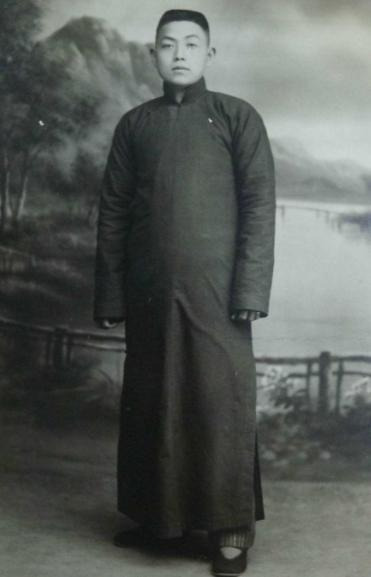
Source here
Photograph of a man in changshan.
The Manchu womenswear story goes like this. In the beginning of the Qing Dynasty in the mid 17th century Manchu women wore robes very similar to those of Manchu men, collarless, floor length and closed with frog closures. There were two styles, the 衬衣 chenyi which opens on the bottom right side where the closures are, and the one with slits down both sides (like the cheongsam) which developed later, called a Chinese word I don’t know how to spell because I’m illiterate. In the 19th century Manchu women were also inspired by Han Chinese women’s fashion and added standing collars to their robes and they remained this way into the 1920s and 30s, so there was a possibility they influenced the design of the cheongsam. The common word for cheongsam in Mandarin is 旗袍 qipao, which means “banner robe”, banner being a reference to the Qing Dynasty Manchu eight banners. From the Mandarin word it could be deduced that the source of inspiration for cheongsam was Manchu womenswear.
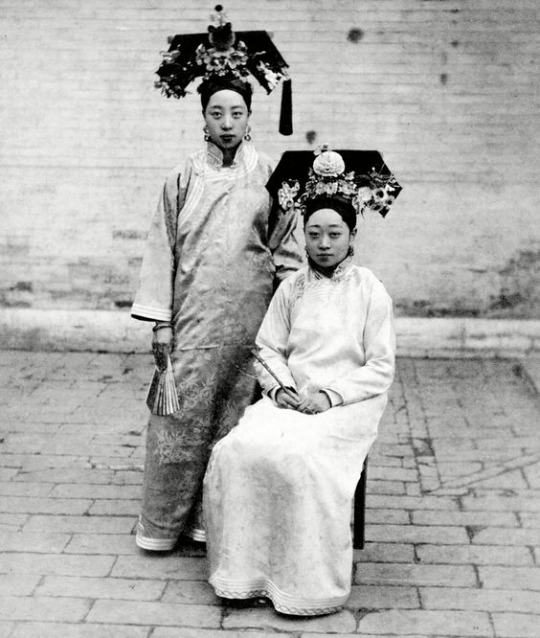
Source here
1910s/20s photograph of two Manchu ladies.
For me personally, the Manchu womenswear explanation makes a bit more sense because if you look at photos of Manchu women’s clothing in the 1920s and 30s they visually resembled the design of cheongsam with the trims and patterns. However, the true inspiration for the cheongsam may as well have been a combination of all the factors listed above, or none of them.
Silhouette
Like I briefly discussed in the post on 1920s silhouette, the late 20s/early 30s silhouette was a knee length, skimpy dress with tight sleeves (could be short or long) and a standing collar. This could take the form of cheongsam or a two piece combo with a long vest and long sleeved shirt. The hem of the dresses could either be flared like trendy Western dresses or have short slits down both sides. It should be noted that the slits in the late 20s and early 30s were very short, usually less than 10cm (approximation by looking, I don’t own any period originals), because the skirts were already quite short and roomy so didn’t require high slits to allow ease of movement. The waistline was emphasized but the overall silhouette still appeared boxy due to the flat chest. The early 30s silhouette was peak Deco and deserves more recognition; oftentimes it gets incorrectly categorized as 20s because it looks like a stereotypical flapper dress, but this silhouette was very specific to 1929-1931.

Source here
Kwong Sang Hong ad from 1930. The lady on the left is wearing a two piece combo----the vest and sleeves are separate.
By 1932 the skirt has become a tad longer but not longer than mid calf, and soft, drapey fabrics were used instead of the more stiff and structured fabrics of 1929-1931. Although the cheongsam was becoming increasingly popular, the aoqun didn’t die, it had crystallized (Drag Race reference) and adopted the same silhouette as the cheongsam: fitted at the waist and with form fitting sleeves. In fact it never really died out, aoqun and aoku are still alive and well today in rural areas. The folk/traditional outfits of many rural Chinese communities today take the form of aoqun and aoku because the cheongsam was worn primarily in the cities and didn’t quite spread to the countryside.

Source here
Kwong Sang Hong ad from 1932. Here you could see the increasing length of the skirt.
The iconic/stereotypical long silhouette came into being around 1934. All of a sudden, the cheongsam became more unified in design elements; collars were always very tall and closed by three or four pankou at the front, sleeves were always either short or full length and the hem was always ankle length. Because of the increased length of the cheongsam, higher slits had to be made to allow freedom of movement. These usually reached the knees or mid-thigh. Around 1934-36 the trend of layering with transparent outer dresses invented in the late 20s came into full fruition. There were many examples of women wearing a transparent/translucent outer cheongsam, showing a petticoat with spaghetti straps underneath, which could have a flared hem or slits like the outer layer. These were usually but not always white, and commonly had lace trim. This petticoat was not the innermost layer though, shorter petticoats or drawers with camisoles/brassieres combinations were worn as undergarments.

Source here
Cover of The Young Companion from 1934. This magazine is iconic and their covers are great primary sources!

Source: A Weary Traveler on Flickr, link
An ad from 1934. You could see the drawers peeking out from under the slit petticoat.
The aoqun still refused to give up and adapted to the new silhouette. However, it became increasingly rare and fashionable urban women would seldom wear it, so around this time the aoqun evolved into somewhat of a conservative symbol.
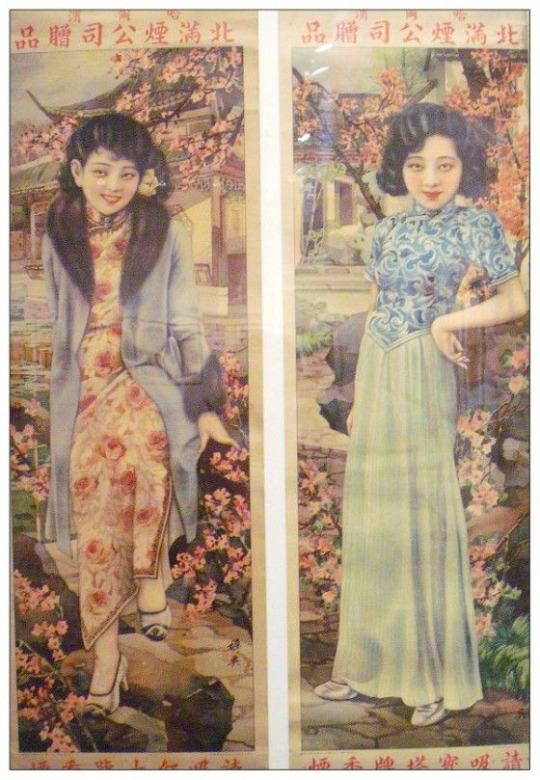
Source here
Cigarette poster from the mid 30s.

Source
Artwork by Ye Qianyu showing cheongsam and aoqun designs, Ling Long magazine 1931 issue 30.
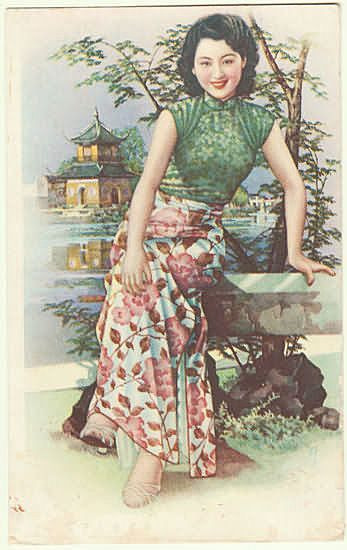
Source
Mid to late 30s aoqun, the skirt is constructed like a cheongsam skirt, with slits.
The short vest trend of the 20s still made occasional appearances but was otherwise practically extinct.
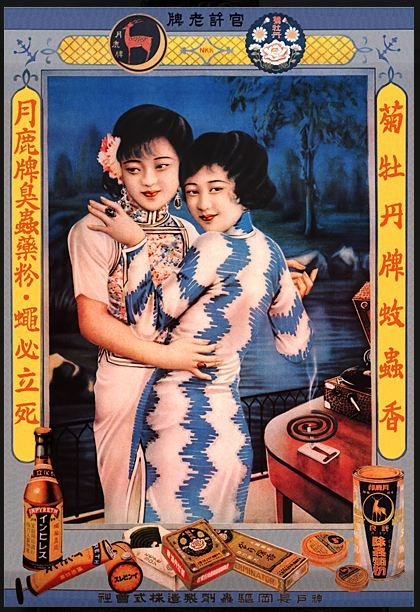
Source here
Mid 30s mosquito repellant ad. (Why do these vintage Chinese advertisements always look so gay? I’m living for it)
More well to do Chinese women began wearing actual Western evening dresses for formal occasions. The Western evening silhouette of this time emphasized slenderness, broad shoulders, tapered waist, small bum and a long, flared skirt hem. It’s easy to see how this silhouette has influenced the silhouette of cheongsam.
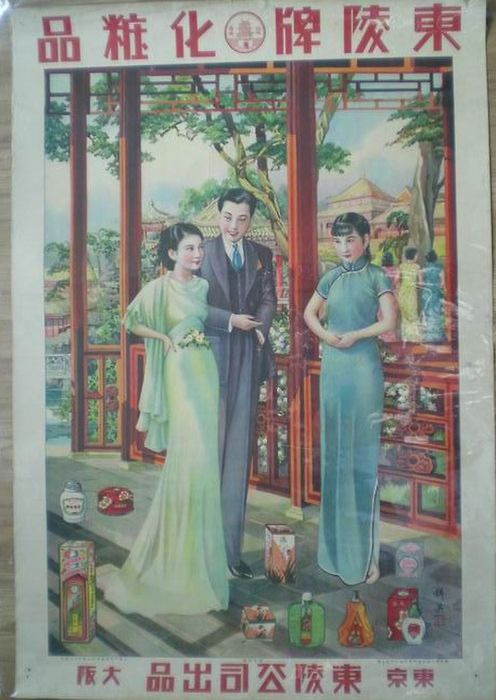
Source: lai yiching0926 on Pinterest, link
A lady in Western evening dress, a man in Western attire and a lady in cheongsam. All fashionable.
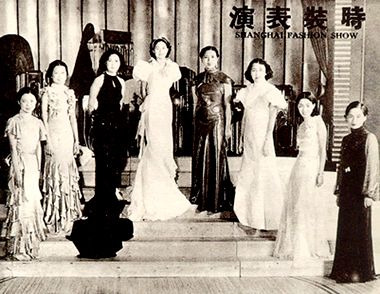
Source
Western evening dresses were a hit among actresses.

Source
Hu Die in an evening dress with puffy sleeves and a train.
Around 1936-37 the design of cheongsam became less extravagant. The transparent trend had significantly toned down and most cheongsam of the late 30s were of opaque fabric. Cap sleeves (very short sleeves that reach out just a bit from the shoulder) became more common at this point, replacing the short and long sleeves. The slits moved lower, often knee length. The collar also began to become shorter. This increasing interest in simplicity may have something to do with the ongoing war with Japan and the scarcity of materials it caused, but I’m very uninformed on political history of this era so if you know more about it please leave a comment.
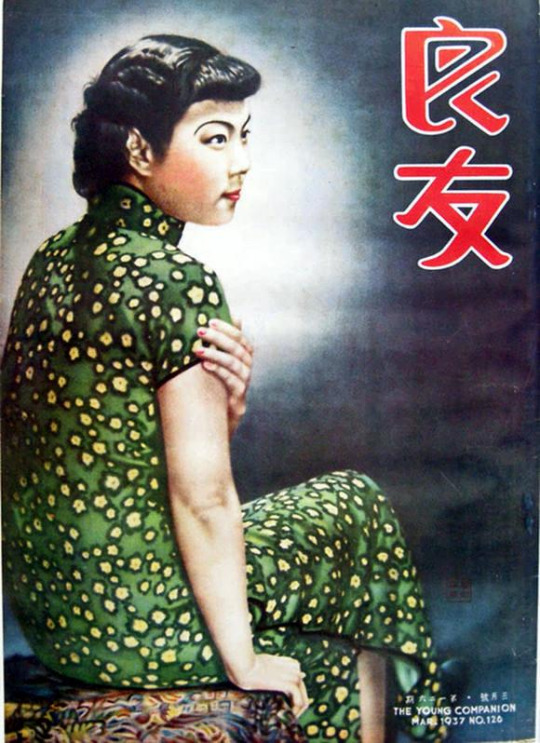
Source here (the original page disappeared, I found this from a Baidu image search)
Cover of The Young Companion from 1937.
By the late 30s, especially 1938-39, almost all cheongsam had cap sleeves----or were straight up sleeveless----and a low collar accommodating one to two buttons. The slits were usually knee length or lower, but the overall cut of the skirt was more generous and roomy than the mid 30s so it was still fairly easy to move in. The transition to the 1940s silhouette is almost complete.

Source here
Late 30s/early 40s poster.
A note about the construction of clothes in this period. Western dressmaking techniques were still not used on the main body of the dresses----there were no darts or tucks to take in the waist, the hourglass shape was achieved by curvy front and back pattern pieces; I talked about the Chinese dressmaking and pattern drafting method in my 1920s post. To clarify the confusion about the 中缝 center front seam in that post, by relooking at 20s and 30s photographs of dresses with striped patterns it’s obvious that there was no shoulder seam and no center front/back seam, so I deduce the front and back pieces of 30s cheongsam were one single piece cut on fold at the shoulder seam and connected only at the closures and underarm seams. I’ve read about this technique called 拔襟 where in order to make the side closures meet after binding and using the seam allowances at the raw edges, dressmakers would just wiggle and stitch the cheongsam together as usual, causing some parts to be slightly on bias and fit better. The article is here. This wasn’t yet the case in the 1910s, as some photographs showed robes with an obvious center front seam. This was probably because 1920s and 30s clothes became much more form fitting and therefore required less fabric so the pieces could be fitted on a continuous length of fabric. Dressmakers were also no longer troubled by the narrow fabrics of pre-industrial times----fabrics in the Ming Dynasty were commonly around 60cm wide, very difficult to cut the wide robe pieces on a single length of fabric----as machine spun fabrics could be much wider.
Design details
The beginning of the 30s continued the use of unusual Art Deco fabrics invented in the late 20s. There was this trend of attaching flowy pleated fabric/ruffles to the sleeves, making the sleeves flared and drapey; this was sometimes also done to the main body of the dress, resembling early 20s Western eveningwear decoration techniques.

Source here
The collar of the early 30s was often side closing or had concealed closures, so the front looked like a continuous piece of fabric, unlike earlier and later collars which unanimously had visible front pankou closures. The skirt hem could be finished with binding, scalloped/geometric edges, uneven hems or have no visible finishes at all i.e. raw edge enclosed in lining. Patterned trims were less popular than they were in the 1910s and 20s but still in use.
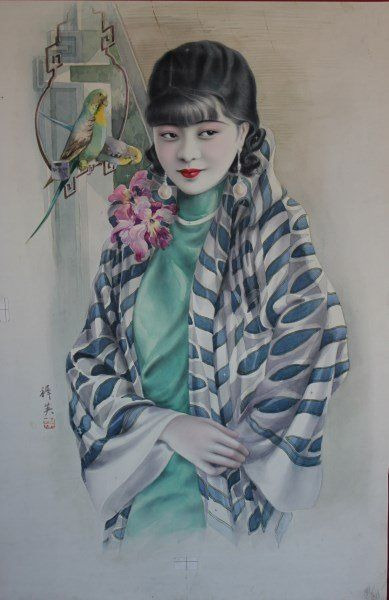
Source here
Early 30s portrait, side closing collar.
The most noteworthy design detail of mid 30s cheongsam was, in my opinion, the use of binding. Since the overall 30s aesthetic stressed simple elegance, beading, flowers, pearls and other late 20s decorations disappeared and 30s cheongsam relied on only the cut and the fabric to be beautiful; binding was therefore a good way of adding accents to the otherwise plain garment. 30s cheongsam could sometimes have two or even three rows of binding but thin, single row binding was also used and equally fashionable.
Something important about the collar: a big departure from the 20s/early 30s side closing, smooth collars was that the collars of the mid 30s were always front closing and more rounded around the edges, resembling what people nowadays would call a Chinese collar. However these were very, very tall and would cover the neck completely without leaving a gap down the front like a lot of modern cheongsam collars do (the gap is also more of a 50s and 60s thing). Between around 1933-36 it was very common to have two rows of wide binding, usually in a shiny fabric. I speculate that the double row binding was constructed by first stitching two pieces of binding together right sides together, then attached to the raw edge as one piece of binding after ironing open the seam. If anyone is a period cheongsam maker please comment about this.

Source here
High collar, double row binding (also used as decorative element), photograph from mid 30s.
Another style of binding was three rows of very thin binding with some space between them. I’m not very sure how this would be constructed so I assume the inner two rows were simply topstitched and then folded over and finished by hand with whipstitches or backstitching through the two invisible layers. I remember reading somewhere that this finish is called a 电车滚 (“train track binding”) because it looks like train tracks, but I’m not sure. This style was popular throughout the 30s but was slightly more common in the later part of the decade.
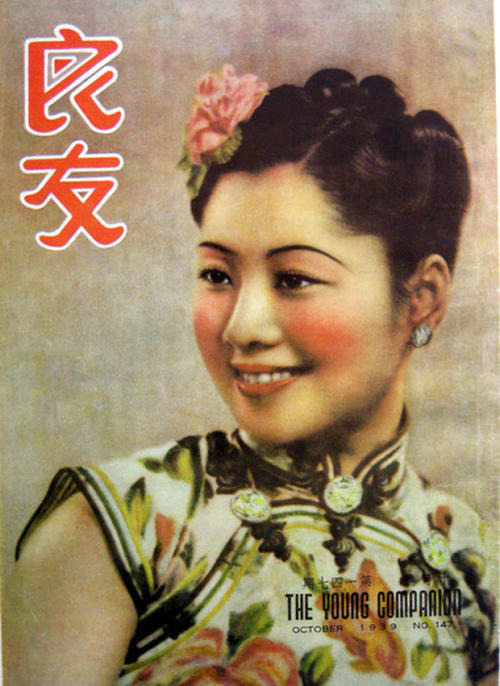
Source here
Cover of The Young Companion from 1939. Triple row binding with spaces in between.
Fabrics with a relatively large, repetitive pattern, such as florals or geometric print, were the most common. Toward the end of the 30s plaid and checkered prints were especially popular as well, usually in earth tones. Completely plain fabrics, or unicolor fabrics with tone on tone embroidery could be used as well. Contrary to popular modern opinion, stereotypically “traditional Chinese” fabrics were not really a thing in the 30s; the shiny silk with small gold embroidery patterns was not popularized until the 50s when some white people in the West decided cheongsam was cool.
Part 4.2 on hair, makeup and accessories coming soon!
#1930s#1930s fashion#vintage fashion#chinese history#chinese fashion#historic fashion#cheongsam#abridged history of early 20th century chinese womenswear
366 notes
·
View notes
Text
Abridged history of early 20th century Chinese womenswear (part 1: 1890s)
*Disclaimer: I mostly talk out of my bum so don’t ask me for academic sources, I would love to know where they are but I haven’t found any reliable ones. I only share my own observations so please read me for filth if I’m wrong.
*There are almost no public domain images I could use because this topic is too obscure so I have to use random images that work and link the sources.
Context
I think there’s not enough content about Chinese fashion history on Tumblr and the Internet in general so I’d like to share my personal knowledge (which is not a lot, but more than nothing). I only know about Chinese fashion history 15th century onwards, the more recent the more I know, so I’m gonna start with the early 20th century.
The 1890s were a very underrated decade in Chinese fashion history. The republican 1920s and 30s are usually credited as the beginning of modern Chinese fashion, mostly because people only consider cheongsam to be valid modern Chinese clothing, which is a bogus claim as aoqun and aoku were just as popular and actually endured longer than the cheongsam. The process of women’s emancipation and the simplification of women’s fashion had already began by the 1890s (perhaps even earlier to a smaller extent) when the monarchy was still around. By the 1900s women’s clothing in China had already been much simplified and modernized, so the 1890s acted as an important transitional period for Chinese fashion.
In order to understand early 20th century Chinese fashion we have to go back a bit into the past to have some clue about the context. Since the establishment of the Ming Dynasty in the mid 14th century Chinese women wore 袄裙 aoqun, a two piece ensemble consisting of a robe and a skirt. At first the robe had a y shaped “kimono collar” as the style is commonly known in the West, then in the late 16th century the 立领 or standing collar was invented (this was different to standing collars used in the 20th century and nowadays, I might explain this later). When the Manchus conquered China and established the Qing Dynasty in the mid 17th century, Han Chinese men adopted Manchu style clothing but Han Chinese womenswear remained independent and separate from Manchu womenswear until it started taking inspiration from Manchu fashion in terms of decoration in the late 18th/early 19th century. However, Han Chinese women retained the habit of wearing a two piece ensemble as the outermost layer, unlike Manchu women, who wore a single floor length robe.
In the second half of the 19th century, the aoqun had a very generous and roomy cut, with huge sleeves in the robe and many pleats in the skirt. The collar of the robe is very low, only providing enough space for one button, a style in fashion since the early 19th century. The robe is closed with frog closures, a braided/knotted style of button which is also somehow the closures used on European hussar uniforms? I don’t know the connection so if anyone has an idea please enlighten me. The robe closes at the side, usually at the right side, however examples of robes with closures on the left or both sides also existed. Before the 19th century, Han Chinese women’s robe sleeves were usually very long, longer than the actual arm of the wearer, but since the 19th century sleeves adopted a more practical length, which was at the wrist.
The skirt was usually of a style called 马面 mamian, a long horizontal pleated piece of fabric with four flat sections, which women wore by wrapping it around their waists twice and tying the tie strings at the waistband. This skirt became very decorative in the 19th century, full of embroidery, tassels and elaborate trim, sometimes giving the illusion of a separate apron being attached (I’ve seen this weird stereotype that traditional Chinese womenswear has a separate apron at the front this is complete bogus). The robes were likewise heavily decorated, sometimes so full of embroidery that the original fabric could hardly be seen; this was especially true of wedding dresses or other ceremonial outfits.
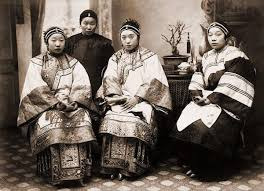
Source: https://www.chinasage.info/women.htm
In addition, pants were also often worn by Chinese women and 袄裤 aoku, the combination of robe and pants, was socially acceptable.
Another noteworthy custom was bound feet, although I don’t know so much about it. The 19th century was the pinnacle of foot binding and fashionable women had incredibly small feet, dubbed “lotus feet”. Women wore baggy stockings underneath their shoes, tied up with garters below the knees. I’m not as knowledgeable about other undergarments of this period unfortunately...

Source: https://www.hpcbristol.net/visual/ch-s03
Silhouette
In the 1890s, the cut of the aoqun began to become more slender and form fitting as a result of increased westernization. The robe was quite long, usually knee length. The sleeves became slimmer and the collar grew taller, being able to accommodate three or more buttons. Pants seem to be very popular in this period, as I have probably seen more contemporary artworks depicting fashionable women wearing pants than skirts. I speculate this may be due to a rising interest in feminism and women wanting more mobility, but that’s just my opinion. The pants were still straight cut but were less roomy than earlier 19th century models. Women began campaigning against bound feet in this period and many drawings depicted women with natural feet. However, if a woman had her feet bound since childhood it’s difficult for them to return to their natural size, so some women who were born in previous decades would still have very small feet, even if they began to reject it at this time. Plain black flats were popular in this time, I have no clue if the construction is Chinese or Western if someone has any idea please enlighten me.

Source: https://www.nas.gov.sg/archivesonline/photographs/record-details/d0743ec7-1161-11e3-83d5-0050568939ad (I think this was photographed in Singapore but the fashions were accurate to mainland China of the period as well)
Design details
The 1890s saw the mass disappearing of wide, elaborate trims around the seams, popular throughout the 19th century. Trims became smaller and more toned down, sometimes being of geometric design. Embroidery on the robe and skirt/pants was rare, if it was done it was usually very small and in a diamond pattern, instead of the more freeform patterns of the previous centuries. The fabrics often had woven in, tone on tone decorations, usually tiny floral motifs or geometric shapes. A general air of simplicity and practicality dominated the fashion of this era.
I’ll post part 2 whenever I want.
#historic fashion#qing dynasty#19th century#vintage fashion#chinese fashion#chinese history#aoqun#abridged history of early 20th century chinese womenswear
160 notes
·
View notes